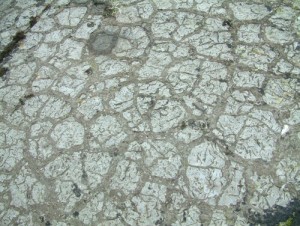The Geology of Strathy Bay
The Strathy Complex
The geology to the west of the River Strathy is dominated by metamorphic gneiss, marble, pegmatites and amphbolites. Metamorphic rocks have enjoyed extreme pressure and temperature deep within the earth and geologists have found at least three phases of deformation in the rocks.
Latest research points to the rocks of the Strathy Complex having been deposited in a region where there were active volcanoes (arc-related) next to a warm sea (marble). The rocks are probably sub-Moine and thus can be considered to be Archean, yet they are distinct from all the other outcrops of Archean rocks in Scotland. Some authors have suggested that the Strathy Complex was related to the Grenvillian mountain building event (1100-1000Ma) that took place on the Rondianian Supercontinent.
Orcadian Lake
To the east of the River Strathy the geology represents a different period in the geological timescale and a very different environment than we have today.
The rocks belong to the Caithness Flagstone series and were formed is a series of fresh-water lakes during the Lower Devonian period (416 – 397 million years ago). The lakes covered an area extending to Caithness, Orkney, Shetland, the Moray coast and to Norway. You are standing on the western margin of this lake system.
The flagstones were deposited on the irregular basement of post-Caledonian land surface. Before these rocks were deposited there was a long period of erosion and weathering. Mountains and hills to the west were cut by rivers and alluvial fans in a fairly hot and arid climate. From the slipway at Portskerra one can see in the cliff face opposite the relationship between the Devonian rocks and the underlying basement. Flash floods resulted in dumps of sandy material on the (sometimes dried out) lake floor. Fish remains have been found in the Baligill area.
The rocks tell a story of erosion of the basement, times of deep and shallow water and times of exposure of the lake bed to the air. In Baligill there is even some evidence of ancient sand dunes. You can see some of these events in the rocks. Look out for cracks associated with drying and thin laminations related to deep water.
The flagstones are known for being split along the bedding plane and are cracked by vertical “joints”. These are taken advantage of by the sea which has created caves (eg. Captain Ivy’s cave) and even a joint that you walk through.



